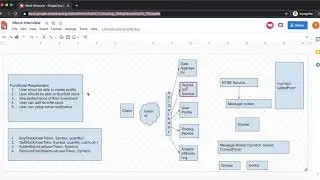Foundation of Distributed Systems Security | Symmetric Keys | Asymmetric Keys | Digital Certificates
Foundation of Distributed Systems Security | Symmetric Keys | Asymmetric Keys | Digital Certificates - In this video, we are discussing important computer cryptography concepts like Symmetric Key, Asymmetric or Public-Private Key Pair and Digital Certificates.
Distributed System Design Interviews Bible | Best online resource for System Design Interview Preparation is now online. Please visit: https://www.thinksoftwarelearning.com?utm_source=Youtube-encryption-keys
Please follow me on / think.software.community if you like to get notified about new course chapters getting added or when we will start another round of mock interviews and you want to participate in mock interviews or any other updates. I will also take your suggestions there about the course and the channel.
00:00 - Introduction
01:00 - Symmetric Keys
02:05 - Asymmetric Keys - Public-Private Key Pair
02:50 - Usage of Public-Private Key Pair
05:10 - Digital Certificates
08:40 - Digital Certificates Usage in Client-Server Communication
09:50 - Final Remarks
Encryption Types:
Encryption is the process of scrambling data so it cannot be read without a decryption key. Encryption prevents data from being read by a 3rd party if it is intercepted by a 3rd party. The two encryption methods that are used today are symmetric and public-key encryption.
Symmetric Key:
Symmetric key encryption uses the same key to encrypt data as decrypt data. This is generally quite fast when compared with public-key encryption. In order to protect the data, the key needs to be secured. If a 3rd party was able to gain access to the key, they could decrypt any data that was encrypted with that data. For this reason, a secure channel is required to transfer the key if you need to transfer data between two points. For example, if you encrypted data on a CD and mail it to another party, the key must also be transferred to the second party so that they can decrypt the data. This is often done using e-mail or the telephone. In a lot of cases, sending the data using one method and the key using another method is enough to protect the data as an attacker would need to get both in order to decrypt the data.
Asymmetric Key/Public Key Encryption:
This method of encryption uses two keys. One key is used to encrypt data and the other key is used to decrypt data. The advantage of this is that the public key can be downloaded by anyone. Anyone with the public key can encrypt data that can only be decrypted using a private key. This means the public key does not need to be secured. The private key does need to be kept in a safe place. The advantage of using such a system is the private key is not required by the other party to perform encryption. Since the private key does not need to be transferred to the second party there is no risk of the private key being intercepted by a 3rd party. Public Key encryption is slower when compared with symmetric key so it is not always suitable for every application.
Check out our following articles:
How to Ace Object-Oriented Design Interviews: / how-to-ace-object-oriented-design-interviews
Elevator System Design — A tricky technical interview question: / elevator-system-design-a-tricky-technical-...
System Design of URL Shortening Service like TinyURL: / tinyurl-design-from-the-bible-of-distribut...
File Sharing Service Like Dropbox Or Google Drive — How To Tackle System Design Interview: / how-to-tackle-system-design-interview-for-...
Design Twitter — Microservices Architecture of Twitter Service: / design-twitter-microservices-architecture-...
How to Effectively Use Mock Interviews to Prepare for FAANG Software Engineering Interviews: / how-to-effectively-use-mock-interviews-to-...
Robinhood Backend System Design - How to receive realtime stock updates: / robinhood-backend-system-design-how-to-rec...
Selecting the best database for your service: / selecting-the-best-database-for-your-syste...
#SystemDesign #DistributedSystems #FAANG #Facebook #Google #Amazon #Apple #Microsoft #Uber #Netflix #Oracle #Lyft #Interview #ComputerProgramming





![CALLIGRAPHY ON IPAD TABLET [Arabic script on an abstract background]](https://images.videosashka.com/watch/Uu6CVlzLGhA)

























